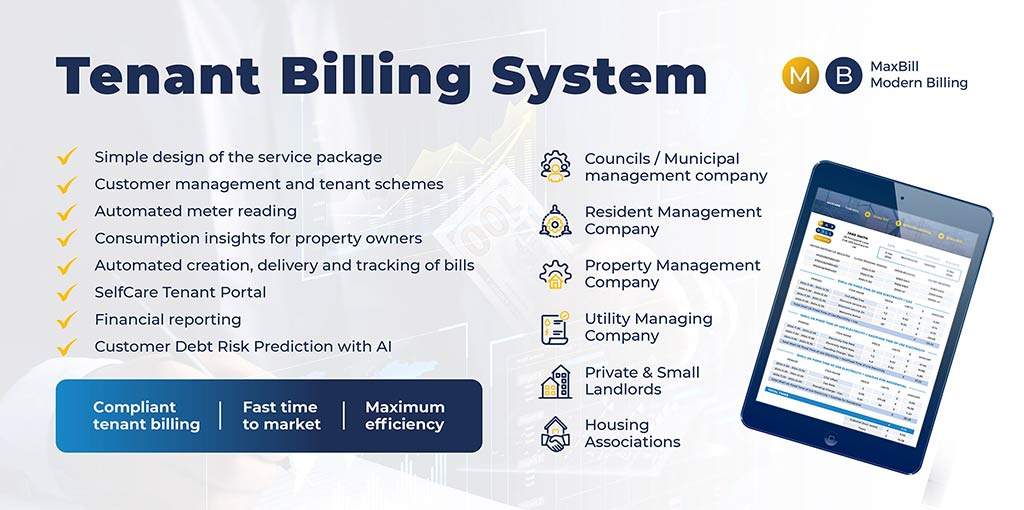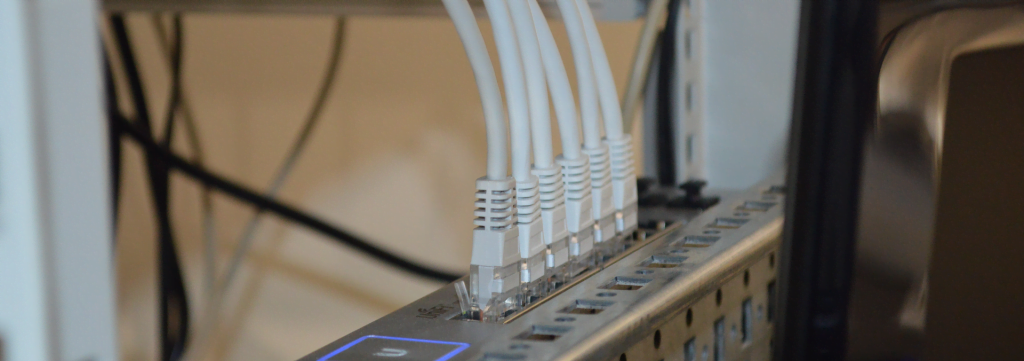Updated: October 2, 2025
Utility submetering is important for both utility organisations and end customers, but for different reasons. Let us name a few.
First of all, submetering contributes more to accurate billing and, thus, reduces disputes. It’s clear that instead of billing based on estimates or master meters, utilities can charge each customer precisely for their usage. That’s why customers are happier.
Besides, regulatory compliance in this industry is a sore subject. Submetering helps utilities demonstrate compliance with cost-allocation rules.
From the business perspective, submetering supports demand response, dynamic tariffs, EV charging allocation, and bundled services. Utilities get more flexibility in product offerings.
Now, as for end customers, they pay as much as they consume, have fewer troubles with utilities, but greater control over their energy efficiency.
In this piece, we’ll dive deep into the subject of submetering and how MaxBill delivers automated utility billing stack to utilities using sub meters.
Key takeaways
- Submetering means individual meters for apartments, each serving a specific type of utility, such as water, electricity, gas, and heat.
- Tenant submeters are a win-win: consumers get fair bills, while utilities get set fair prices and combat bad debts.
- Electricity submetering is useful for cost management and more accurate allocation of electricity costs.
- More and more residents opt for water sub-meters as the most secure way to pay less.
- Utility submetering is particularly instrumental in identifying energy efficiency gaps.
- Ratio Utility Billing System (RUBS) in submetering saves from installing meters for each unit.
- MaxBill covers a full value cycle for utilities leveraging sub-meters.

What is submetering?
Submetering refers to the installation of individual meters for apartments, each serving a specific type of utility, such as water, electricity, gas, and heat. There are still situations where a single meter (for example, for heat) is installed for the entire building, and the amount billed for the billing period for this resource is distributed proportionally among all apartment owners.
When it comes to individual heating systems, where each apartment owner can regulate the temperature, they can influence the amount they ultimately pay. This is impossible with a general meter.
Therefore, submetering has become widespread worldwide. Thus, one can see submetering for electricity, gas submetering, and water sub-metering.
Summary: Submetering refers to the installation of individual meters for apartments, each serving a specific type of utility, such as water, electricity, gas, and heat.
Tenant submetering and multi-tenant submetering system. Why do landlords submeter utilities?
It allows for the efficient and fair measurement and billing of resource consumption by individual households. On the one hand, tenants can regulate their consumption and save on it if necessary, while for landlords, tools like gas, water, or electric sub-meters help better serve clients, set fair prices, and even combat the occurrence of debts from consumers. Hence, the system is mutually beneficial.
Multi – tenant submetering becomes even more useful for businesses, as enterprises consume more services than regular users. This type of billing is more advantageous for them, as these costs can be immediately included in the annual budget, product and service costs, etc.
Summary: individual households control consumption and are billed respectively, while utilities get decreased bill disputes, less debts, and happy I&C cleints as well.
Submetering electricity for the tenant
Submetering electricity is a metering system that monitors and measures electricity consumption at the level of individual units, apartments or commercial premises within a larger building or complex. This can be useful for cost management and more accurate allocation of electricity costs.
Electric sub meters for tenants can be mechanical/digital or smart. Mechanical or digital meters are less expensive, but digital meters offer more features, such as Wi-Fi data transmission and more accurate readings. Smart meters and electric sub meters for tenants transmit real-time data and allow tenants to track their electricity consumption through mobile apps or web interfaces.
Summary: among three types of electric submeters – mechanical, digital, or smart – the latter allow real-time tracking of electricity consumption for even better control and accurate billing.
Water sub-meters for tenants
Water sub-meters for tenants are gaining traction in multi-tenant and other properties, as residents increasingly prefer to pay only for their actual consumption, not a penny more.
“As a multi-tenant billing solution, we anticipate a significant increase in the adoption of submetering systems in residential spaces next year. It’s the most optimal way to protect, support, and improve the area’s waterway and habitat. In fact, some buildings can experience a 90% reduction in water leaks. Needless to say, how much it decreases residents’ bills!” states MaxBill Senior Product Owner Olga Penkova.
Summary: with water sub-meters, residents pay for their actual consumtopm, that’s why they are gaining traction in most property types.
Related:
The Ultimate Billing System for Housing Associations in the UK.

Main reasons why businesses use sub-metering

Utility submetering systems deliver fairness and convenience in billing, in the first place. Here are several other reasons why submetering is a beneficial solution for any business:
- Submetering allows businesses to identify all areas of resource consumption and losses (such as energy) and pinpoint the most costly, energy-intensive processes. This enables businesses to switch to energy-efficient equipment, reduce losses, and decrease consumption intensity where possible. Having real data, businesses can take actionable steps.
- Submetering helps determine whether energy-efficient solutions or resource-saving methods work.
- Multi-tenant submetering in business centres. When multiple tenants operate in the same space, having a meter for each company ensures that businesses do not overpay for resources they do not use.
Businesses of all kinds can benefit from such a strategy. For example, in commercial buildings used by multiple companies, tenant sub-metering allows each tenant to be separately billed for their actual consumption of resources such as water, heat, electricity, gas, etc.
Similarly, sub-metering is useful for large industrial facilities where different production lines may consume varying amounts of resources. It is necessary to assess the efficiency of each process and understand how to optimize operations or reduce costs.
Quite often, submetering is beneficial for hotels and restaurant complexes, enabling such businesses to control and manage energy and water usage in guest rooms and common areas. Even in retail trade, when individual shops lease retail space, multi-tenant sub-metering is useful. This allows for billing based on individual consumption, which is a fair and economically justified decision.
In fact, in any business sector where it is necessary to rent part of premises or use multiple buildings or campuses, this step helps optimise utility costs and maintain clear accounting and reporting.
Summary: CI& organisations benefit a lot from submetering by identifying gaps in resource consumption and losses, assessing energy efficiency solutions, preventing overpayment, etc.
Main types of utility submetering

Utility submetering involves installing separate meters for each resident of a building or each business renting shared space. These meters can track gas, electricity, water, heating, and other services, allowing precise measurement of each consumer’s usage.
Utility submetering has become an essential practice for managing and optimizing energy consumption across various sectors. By implementing energy submetering systems, businesses and residential buildings can accurately monitor and control their use of resources such as gas, electricity, and thermal energy.
Submetering gas usage helps in detecting leaks and ensuring efficient consumption, while electricity submetering provides insights into power usage patterns and identifies opportunities for energy savings.
Thermal submetering, including heat submetering, enables precise measurement and control of heating systems, leading to improved comfort and cost efficiency.
Advanced solutions like multichannel submetering integrate all these functionalities, offering a comprehensive overview of utility consumption and facilitating better resource management.
- Tenant utility submetering is a crucial technology for property managers looking to improve cost allocation and energy efficiency.
- In apartment sub-metering, individual units are equipped with meters that track water, gas, and electricity usage separately, ensuring tenants only pay for what they consume. This system not only promotes fairness but also encourages responsible energy use.
- For commercial submetering, the benefits extend to office spaces where submetering can accurately monitor and bill each tenant’s energy usage.
- By implementing submetering in office spaces, building owners can provide transparent utility billing, which can lead to better energy management and increased tenant satisfaction.
Summary: we identified around 6 types of submters. Once installing one that works best for your clients, cost allocation and energy efficiency are about to improve.
Proportional allocation or RUBS
Ratio Utility Billing System (RUBS) is another method of submetering. This system allocates utility costs based on factors such as the number of residents, apartment size, or a combination of both.
Instead of directly measuring each tenant’s consumption, RUBS calculates a proportional share of the total utility bill for each apartment. This method can save costs on installing individual meters for each unit.
Summary: there’s the method of Ratio Utility Billing System (RUBS) in submetering, saving from installing individual meters for each unit.
Which companies should implement utility submetering?
Installing meters is not as simple as it might seem; hence, submetering is handled by companies specialising in this field, such as utility submetering companies. Often, these are the same companies providing direct services to consumers, or they may hire contractors to perform this work.
Why can’t users install their meters?
The meter must be integrated into the overall project, meet technical standards and requirements, and be accurate. This is essential for both consumers and property owners. Therefore, DIY meter installation is not a feasible option.
The meter must be registered, and the subscriber must be switched to a different billing system. Simply installing a meter does not determine how much a specific consumer will pay; it only measures usage. The system works only when the meter:
- Meets all requirements;
- Is correctly installed;
- Is entered into the system;
- The subscriber is transferred to a different billing system.
- An RBC (read, bill, collect) company is assigned to read the meter data, issue bills, collect payments, and maintain the customer’s payment history.
The RBC company also provides technical support to customers and offers other solutions, such as increasing NOI or reimbursing certain expenses.
Summary: it’s a bad idea of DIY meter installation since the whole switching and billing processes are linked to it. Trust your utility!
What are the differences between metering and submetering?

As you may have seen from the examples above, building-level metering and utility submetering are different concepts. The commonality between them is that they involve measuring the precise amount of services or resources consumed.
When referring to the measurement of services delivered to a building, enterprise, or other facility as a whole, it is about metering. In this case, a single main meter is installed, which records the total consumption of a particular resource. Such a meter might be located in the building’s basement, for example.
Meanwhile, submetering is a way of more specifically and accurately measuring the consumption of water, electricity, heating, or other utilities. With submetering, in addition to the main building meter, each consumer, whether commercial or residential, can measure how much they have consumed individually.
This additional meter is installed in the premises (apartment, office, production facility) after the main building meter or even instead of it.
Thus, the key difference between building-level metering and submetering lies in where the meters are located and for what purpose. When a single main meter for the entire building is sufficient for billing purposes, it can be used alone. However, when it comes to commercial consumption of utilities (enterprises, factories, and supermarkets), businesses can significantly save costs by using submetering.
Summary: submetering is more about individual consumption and can be installed after the main building meter or instead of it. They also differ by location and purpose.
Related:
Smart Meter in Europe 2024-2030 to Transform Utilities and Empower Consumers.
What Is Net Metering, and How Does It Work?
Covering Half-Hourly Meters for Large Businesses and Industries.
Submetering practices in different countries
United Kingdom
- Regulatory Framework:
- Submetering is widely used in multi-tenant buildings, especially for residential, commercial, and industrial properties.
- Regulated under the Electricity Act 1989 and subsequent amendments.
- Ofgem oversees the electricity market, ensuring fair billing practices.
- Landlords or property managers must comply with heat network regulations if heating is involved alongside submetering.
- Usage:
- Common in rented properties, where tenants are billed based on actual consumption rather than estimates.
- Multi-tenant submetering often includes features like prepayment systems or integrated energy management.
- Challenges:
- Ensuring accurate calibration of submeters.
- Transparency in billing to avoid disputes with tenants.
- Trends:
- Growth in smart metering integration to provide tenants with real-time usage data.
- A push for net-zero buildings, encouraging submetering for monitoring energy efficiency.
Germany
- Regulatory Framework:
- Governed under Energiewirtschaftsgesetz (EnWG) (Energy Industry Act) and Messeinrichtungsordnung (Metering Ordinance).
- Submetering is tightly regulated to ensure tenant rights are protected.
- The Bundesnetzagentur oversees compliance and consumer protection.
- Usage:
- Common in multi-family housing and commercial properties.
- Landlords often partner with submetering service providers to handle billing and data collection.
- Challenges:
- Strict privacy laws (e.g., GDPR) add complexity to data collection and sharing.
- The high cost of upgrading legacy infrastructure to smart submeters.
- Trends:
- Strong emphasis on energy efficiency and transparency, driven by EED (Energy Efficiency Directive) mandates.
- Submetering is being integrated with district heating systems and renewable energy sources.
Spain
- Regulatory Framework:
- Governed under the Electricity Sector Law (Ley del Sector Eléctrico) and related regulations.
- Submetering is less common than in Germany or the UK but is growing, especially in new developments.
- Usage:
- Primarily in residential multi-tenant properties and tourism-oriented properties, such as hotels and resorts.
- Increasing use in community energy projects, such as shared solar.
- Challenges:
- Adoption is slower due to cost barriers and a lack of awareness.
- Metering standards and calibration requirements vary, creating inconsistency in submetering practices.
- Trends:
- Growing push for energy transparency and smart grids, fueled by EU directives.
- Rising interest in shared energy models, where submetering enables equitable distribution of renewable energy.
United States
- Regulatory Framework:
- Regulation varies state-by-state, with no federal standard for submetering.
- States like California and New York have specific submetering rules, while others, such as Texas, provide incentives for using submeters in energy-efficient buildings.
- The Public Utility Commissions (PUCs) in each state regulate submetering practices.
- Usage:
- Widely used in residential and commercial properties to promote energy efficiency.
- Often paired with demand-side management programs, incentivizing tenants to reduce usage during peak hours.
- Challenges:
- Compliance with local laws, particularly regarding tenant billing practices.
- The need for regular meter inspections and certifications.
- Trends:
- Rapid adoption of IoT-based submeters, providing granular usage data.
- Focus on renewable energy tracking, especially in states with renewable portfolio standards (RPS).
What makes the ultimate billing solution for submetering: key characteristics?

The ultimate billing solution for utility submetering should possess the following key characteristics:
- Accuracy: Precise measurement and recording of individual utility usage to ensure fair billing.
- Transparency: Clear and understandable billing processes that residents and businesses can trust.
- Flexibility: Ability to handle various billing methods, including true submetering and RUBS, to suit different property types.
- Automation: Streamlined processes for billing, collection, and reporting to reduce manual effort and errors.
- Integration: Compatibility with existing property management systems for seamless operation.
- Scalability: Capable of handling properties of all sizes, from small multifamily units to large commercial complexes.
- Support: Reliable customer service and technical support to address any issues promptly.
- Compliance: Adherence to regulatory standards and requirements to ensure legal and operational compliance.
- Energy Efficiency: Tools and insights to help residents and businesses reduce consumption and save costs.
- Data Analytics: Advanced analytics to provide actionable insights for optimizing resource usage and enhancing efficiency.
Summary: we identified the top 10 characterisitcs that define the right billing solution for utilities leveraging sub-meters. To sum up, they fell into accuracy, analytics, automation, compliance and ops excellence.
How Maxbill can help utility companies
Maxbill is a company that undertakes the full cycle of necessary interactions with each consumer, acting as a contractor for utility companies.
Maxbill helps utility companies optimise their operations and automate processes, as well as reduce the issue of customer debts. This is achieved by offering consumers a convenient electronic account, measuring the actual consumption of services, maintaining a payment history, issuing bills, and sending payment reminders.
The service can also forecast which users might potentially encounter debt problems for consumed services — these warnings are generated by the system based on data analysis using AI.
By ensuring accurate and transparent billing processes, providing reliable analytical tools, and even offering the development of multi-level tariff systems, Maxbill facilitates the work of utility companies and increases customer satisfaction.
Summary: Maexbill energy billing and CRM deliveres ultimate billing system for utilities leveraging surmeters, hyperautomation, robust debt management, configurable product catalog, and modern self-serve portal for efficient comms with consumers.
Why is integrating submetering with comprehensive billing the best possible option?
Integrating submetering with a comprehensive billing and payment platform offers several advantages over traditional submetering methods:
- Automated Billing and Payment Processing: Traditional utility submetering measures individual consumption but often requires manual billing and payment collection, which can be time-consuming and prone to errors.
An integrated system automates these processes, enabling direct online billing and payment for utilities like electricity and water. This automation, built into tenant sub-meterin,g reduces administrative burdens and minimises issues related to payment collection, especially from unreliable tenants.
- Flexible Payment Options within Utility Submetering Systems: Integrated platforms can offer various payment modes, including prepaid, postpaid, and preset limit options. This flexibility allows tenants to choose payment methods that best suit their preferences, enhancing satisfaction and ensuring timely payments.
- Real-Time Consumption Monitoring: With the integration of smartphone applications, tenants can monitor their utility consumption in real-time. This transparency encourages more conscious and rational resource use, promoting sustainable behavior and potentially reducing overall consumption.
- Simplified Infrastructure Requirements for Submetering: Traditional submetering systems may require complex infrastructure, including meters with RF or PLC communication, communication equipment like concentrators or gateways, servers, and head-end software for meter reading. An integrated solution simplifies this setup, often limiting the landlord’s effort to simple registration via a smartphone application and setting up utility prices.
- Enhanced Energy Management for Electric Submeters: Integrated systems can provide services for consumption monitoring and energy balance in multi-tenant properties. Access to various reports enables data analysis and informed decisions to optimise energy efficiency, contributing to sustainable development in the rental and hospitality industries.
Summary: Excel-based billing can sabotage operational excellence of utilities leveraging AMI, incl. submetering. On the contrary, modern automating billing streamlines ops, maintain healthy cash flow and keep customers happy.
The Top Trend in Submetering: AI-Billing
We’ve had the webinar “8 AI cases in Utilities: How to generate new revenue and raise CSAT by 70%”. AI adoption in different industries and their specific processes was one of the trends, obviously. Utilities are not an exception. However, AI made the sector ask itself: are you a tortoise or a hare?
This means, are you leveraging AI in marketing and sales, customer service, billing, disputes, debt, metering, etc.? Speaking about billing,
“AI-driven billing is already there. It will transform the way utilities serve clients. Besides this, we aim to help utilities maintain a low-cost operations model, creating a win-win for businesses and customers alike,” says Roni Rechter, AI Project Manager at Maxbill.

































